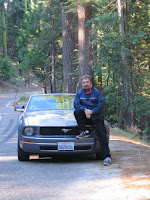Years ago, my grandfather introduced my brother, my sister and me to the joyous pastime of stream damming.

The North-West of England, where I grew up is particularly well-endowed with shallow, stony-bedded streams, which are ideal for damming and, over the years, we spent many holiday afternoons building walls of river stones.
This year, in the Lake District, I introduced my two girls to this ancient pastime.
They were instantly hooked and spent the rest of that afternoon trying to dam up the stream you can see in the picture above.
It is a curiously addictive occupation but at the same time, it is almost completely futile - the river always wins! - and yet, as my daughters were discovering, the urge to try is irresistible.
Once I had shown them the basic technique of piling up big stones and then filling in the gaps between them with smaller stones, I left them to it and found a comfortable spot on the stream bank to spectate from.
As I watched them laughing and splashing - up to their knees in cold mountain water - I started to wonder just what it is that makes damming up streams so enjoyable.
A few minutes later I was summoned to the dam to view the progress - "Daddy, look how much deeper the pool is now."
The evidence was clear. The pool behind the dam had risen to the point where trousers were having to be hitched up to keep them out of the water.
This was the measure of success - rising water level.
None of us were bothered that we had not stopped the stream completely. Nor did we care that our dam was unlikely to survive the first heavy rains of the winter. All that mattered was that something had changed because of what we had done and that was enough to keep us there for hours.
 Of course, it didn't hurt that we were on holiday and that we were out in the sunshine, surrounded by beautiful scenery but still, it was a great reminder of just how motivating a sense of progress can be.
Of course, it didn't hurt that we were on holiday and that we were out in the sunshine, surrounded by beautiful scenery but still, it was a great reminder of just how motivating a sense of progress can be.I thought some more about this on the drive back to our caravan.
I am quite a goal-driven person and I really enjoy making things happen and getting things done. I get a huge sense of satisfaction when I complete a big project or achieve a long-term goal.
However, the downside of constantly focussing on outcomes and achievement is that, on most days, there isn't a completed project or fulfilled goal to celebrate. Obviously, the desire to get to the point where there is something to celebrate is one of the main components of motivation but there is a delicate balance between drive and frustration .
If I allow myself to become excessively focussed on the final result I am likely to slide towards frustration and de-motivation, especially when the end seems too far away or the outcome is uncertain.
This is the point at which the art of cultivating a sense of progress can make all the difference.
Learning to celebrate small achievements can keep us energised and determined as we plod towards the victories and successes that give us a sense of progress and satisfaction. It really doesn't matter what those small achievements are but, just as my daughters summoned me regularly to measure the depth of the pool they were creating, it is important that we have some measure of progress.
That might be choosing the wall paper for a room we are about to decorate, completing a chapter of the book we are writing, choosing the theme for the presentation we are making, reaching the half-way point in the report we are writing or surviving the first 5 minutes of a Zumba class.
Once we have measured progress we need to recognise and celebrate it.
Telling someone else is probably the most common way to mark an achievement but finding what works for you is the key.
Crossing something off your "to do" list, printing out your newly-written chapter or FaceBooking photos of your partly-painted lounge can all help you tap in to the surprisingly motivating joy of progress.




.jpg)




